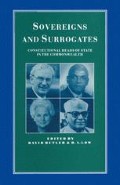Abstract
Under Section 9 of the Constitution Act, 1867, ‘The Executive Government and Authority of and over Canada is hereby declared to continue and be vested in the Queen’. However, most of these powers are in fact exercised by her surrogates, the Governor-General and the provincial Lieutenant-Governors, as subsequent sections of the Constitution (notably SS. 10, 12, and 90) make clear. In general the ‘prerogative’ powers which lay outside the jurisdiction of the Canadian government before the Statute of Westminster were gradually devolved on the Governor-General. Initially such matters as the appointment of ambassadors and the issue of letters of credence were submitted directly to the Sovereign by Canadian ministers. These matters, in current practice, are now handled by the Governor-General. The one remaining matter of importance which is still dealt with by the Queen is the appointment of the Governor-General. Otherwise the Queen, apart from largely ceremonial occasions on fairly frequent royal visits, plays a very small Head of State role in Canada.1
Access this chapter
Tax calculation will be finalised at checkout
Purchases are for personal use only
Preview
Unable to display preview. Download preview PDF.
Notes
It will be recalled that during the Australian constitutional crisis of 1975, the Queen’s Private Secretary, Sir Martin Charteris, in writing to the Speaker of the House of Representatives, explained ‘As we understand the situation here, the Australian Constitution firmly places the prerogative powers of the Crown in the hands of the Governor-General as the representative of the Queen in Australia. The only person competent to commission an Australian Prime Minister is the Governor-General, and the Queen has no part in the decisions which the Governor-General must take in accordance with the Constitution. Her Majesty, as Queen of Australia, is watching events in Canberra with close interest and attention, but it would not be proper for her to intervene in person in matters so clearly placed within the jurisdiction of the Governor-General by the Constitution Act’. Quoted in Geoffrey Sawer, Federation under Strain (Melbourne University Press, 1977, p. 211). Even as early as 1937, Sir John Simon, the Home Secretary, in defending the exclusion of the Dominions from the Regency Act of that year, noted that the matter had been discussed with Dominion Prime Ministers in 1935, and it had been agreed that it was not necessary to make the legislation apply to the Dominions in conformity with the Statute of Westminster because ‘A Dominion which has a Governor-General gets its ordinary day by day business done in the name of the Crown by the executive action of the Governor-General. The state of health or absence of the Sovereign does not hold up the machinery at all’. Great Britain, Parliamentary Debates (Commons), 319 H.C. Deb. 5s., February 2, 1937, pp. 1452–3.
D.A Low (ed.) Constitutional Heads and Political Crises. Chapter XIII.(London, 1988). pp. 218–9.
John T. Saywell, The Office of Lieutenant-Governor. Toronto, 1957 p.21.
K.C. Wheare, Federal Government. London, 1953, p. 11.
The case was Gallant v. R. [1949] 2 D.L.R. 425. For the whole episode see Frank MacKinnon, The Government of Prince Edward Island. (Toronto, 1951) pp. 155 ff.
Paul Martin, A Very Public Life. Vol.II: So Many Worlds. Toronto, 1985, p. 305.
Public Archives of Canada, King Diary. May 18, 1938. pp. 471–4.
H.F. Angus, ‘The British Columbia Election, June, 1952.’ Canadian Journal of Economics and Political Science XVIII:4 (November, 1952) p. 518.
On the Quebec succession see J.R. Mallory, ‘The Royal Prerogative in Canada: the Selection of Successors to Mr. Duplessis and Mr. Sauvé.’ Canadian Journal of Economics and Political Science. XXVI:2 (May, 1960) p. 314.
Senate. Proceedings of the Special Senate Committee on the Constitution. Tuesday, November 21, 1978. p. 2:13.
Senate. Proceedings of the Special Senate Committee on the Constitution. November 21, 1978. pp. 2:25–6.
Quoted in J.R. Mallory, Social Credit and the Federal Power in Canada. Toronto, 1954, p. 75.
Editor information
Editors and Affiliations
Copyright information
© 1991 David Butler and D. A. Low
About this chapter
Cite this chapter
Mallory, J.R. (1991). Canada. In: Butler, D., Low, D.A. (eds) Sovereigns and Surrogates. Cambridge Commonwealth Series. Palgrave Macmillan, London. https://doi.org/10.1007/978-1-349-11565-5_3
Download citation
DOI: https://doi.org/10.1007/978-1-349-11565-5_3
Publisher Name: Palgrave Macmillan, London
Print ISBN: 978-1-349-11567-9
Online ISBN: 978-1-349-11565-5
eBook Packages: Palgrave Political & Intern. Studies CollectionPolitical Science and International Studies (R0)

